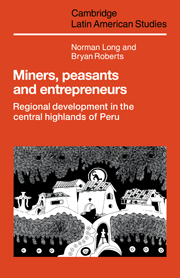Book contents
- Frontmatter
- Contents
- List of tables
- List of figures
- List of maps
- Preface
- 1 Regional development in an export economy
- 2 The development of a regional economy in the central highlands
- 3 The Mining Corporation and regional development
- 4 Class relations, local economies and large-scale mining
- 5 Highland puna communities and the impact of the mining economy
- 6 Migration and social differentiation amongst Mantaro valley peasants
- 7 Industrialization and the emergence of an informal regional economy
- 8 The village economy, agricultural development and contemporary patterns of social differentiation
- 9 Regional commitment among central highlands migrants in Lima
- 10 Confederations of households: extended domestic enterprises in city and country
- 11 Regional development in peripheral economies
- Notes
- Bibliography
- Index
- Titles in the series
5 - Highland puna communities and the impact of the mining economy
Published online by Cambridge University Press: 07 May 2010
- Frontmatter
- Contents
- List of tables
- List of figures
- List of maps
- Preface
- 1 Regional development in an export economy
- 2 The development of a regional economy in the central highlands
- 3 The Mining Corporation and regional development
- 4 Class relations, local economies and large-scale mining
- 5 Highland puna communities and the impact of the mining economy
- 6 Migration and social differentiation amongst Mantaro valley peasants
- 7 Industrialization and the emergence of an informal regional economy
- 8 The village economy, agricultural development and contemporary patterns of social differentiation
- 9 Regional commitment among central highlands migrants in Lima
- 10 Confederations of households: extended domestic enterprises in city and country
- 11 Regional development in peripheral economies
- Notes
- Bibliography
- Index
- Titles in the series
Summary
In this and the next chapter, peasant responses to the expansion of capitalism are examined. Peasant communities entered into direct relations with highland mining centres and with commercial plantations of the coastal area where there was a growing demand for labour. Much of this labour, however, retained a base in the village, continuing to own or have rights to individual or communal land and leaving wives and children behind to care for livestock and the upkeep of family property. The situation that developed between the mines, plantations and peasant villages was akin to that characterized by De Janvry and Garramon (1977) who argue that ‘cheap’ labour is a critical element in the functioning and profitability of capitalist enterprise in peripheral economies.
Although we do not wish to debate the issue here of whether or not the peasant subsistence base is essential to the logic of capital accumulation in the periphery, we claim that the relationship between capitalist enterprise and peasant villages in the central highlands served the interests of both parties. For the first half of the twentieth century, the best available labour force for the mines and plantations was located in the villages of the central highlands; conversely, the increase in village population in relation to land resources made wage labour a necessary complement to agricultural production. In this sense, the expansion of export production shaped the pattern of development of both puna and valley communities. This expansion created new resources as well as undermining some existing economic activities. Moreover, it had an uneven impact on the region, depending on the resources available to the villages and their type of integration into the export economy.
- Type
- Chapter
- Information
- Miners, Peasants and EntrepreneursRegional Development in the Central Highlands of Peru, pp. 88 - 106Publisher: Cambridge University PressPrint publication year: 1984



